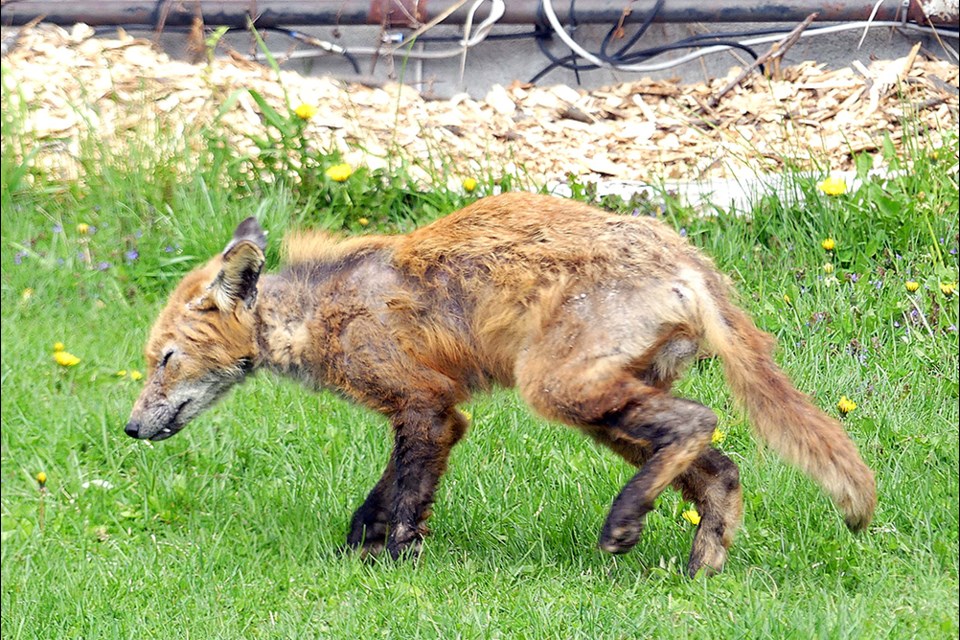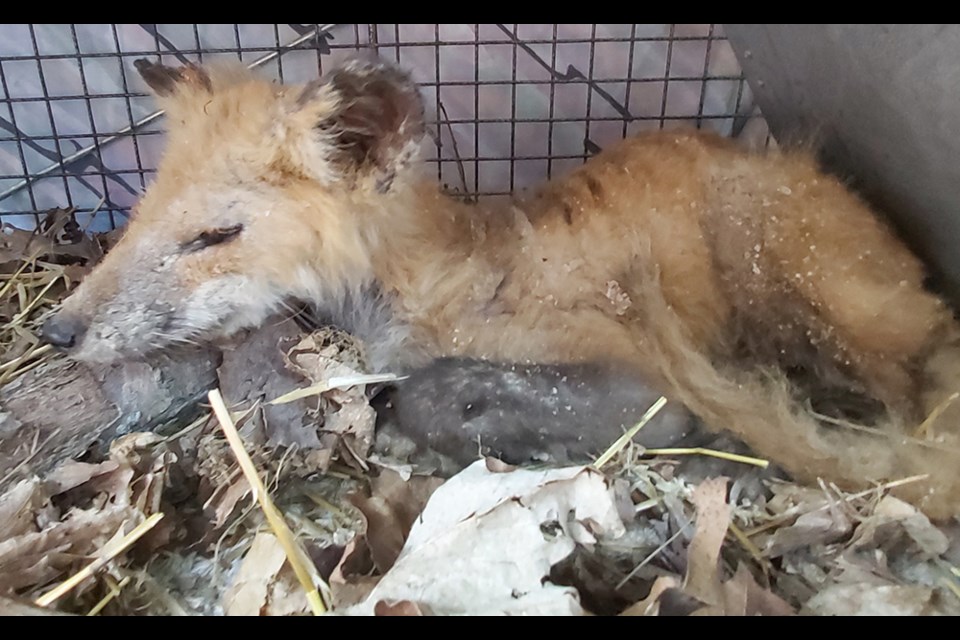A fox trots down a road in Innisfil. Its muzzle looks patchy, its eyes are almost sealed shut with a crusty discharge; the tail is thin and appears to have lost most of its brushy fur.
Chances are the fox has mange.
Sarcoptic mange – an infestation of the parasitic mite sarcoptes scabiei – is contagious, and common in a wide range of animals, including domestic livestock, squirrels, dogs, hares, coyotes, and wild foxes.
It can be fatal.
Mites burrow into the skin, causing intense itching. Frequent scratching can lead to hair loss, lesions and infection. Severely infected foxes may be unable to regulate their body temperature, due to the loss of fur, and have little energy to hunt. They can succumb to infection, hypothermia, and starvation.
But not if ecologist and wildlife photographer Jen Howard can find them before it is too late.
Howard has been working with Procyon Wildlife rehabilitation and education centre for the last five or six years, writing for their newsletter, taking photos and raising funds. But Procyon is not a rescue operation, so when she spotted a fox suffering from mange, back in January, she decided to act on her own.
Using a live trap, she captured the sick fox, and brought it in to Procyon, to be treated, rehabilitated, and ultimately released back into the wild.
"That was kind of all I was planning to do," she said: rescue one fox. "Two days later, I got a call to get a fox in Belle Ewart."
That was the start of Howard's campaign to live-trap and treat foxes suffering from sarcoptic mange, and ultimately release them back into their natural habitat. So far this year, the program has successfully treated fifteen infected animals - and earned Howard the title of "The Fox Whisperer" at Procyon Wildlife.
Howard was the guest speaker at last week's meeting of the Rotary Club of Innisfil, held at the Innisfil ideaLAB & Library in Alcona, in person and via Zoom.
She explained that live-trapping sick foxes takes knowledge of the behaviour of the animals, and patience. It took three months to catch "Myron," who was spotted in the Gilford area. By the time he was finally captured, he was at death's door — practically hairless, emaciated, eyes crusted shut.
“I was quite concerned he wasn’t going to make it,” Howard said, showing the 'before' photos and photos taken after about five weeks of treatment.
Myron is now on the road to recovery, she said. "He's doing really, really well."
Each fox is given a name when brought in to the centre — Spirit, Scout, Bohr, Buddy, Paddy, Kiara, Yoda, Millie, Myron — then weighed and photographed, before being assessed for treatment. It's often hard to see what the fox really looks like when it it first brought in; harder to believe that the starving, lethargic animal will recover.
In fact, Howard said, “We haven’t lost any this year, except one that was hit by a car.”
Capture is stressful for the animals, she acknowledged, but there really is no choice: the medications used are too dangerous to allow for treatment in the wild, which would involve the use of treated bait. The drug used can be fatal to some breeds of dogs and other animals that might find and eat the bait.
To minimize the stress, contact with humans is limited — and Howard suspended the program during the recent heat wave. It was just too dangerous to leave the animals in the traps for any length of time.
“There’s a lot of rules and regulations you have to follow,” she said, including always wearing gloves when handling the animals because “these are a rabies vector species,” even though there have been no reports of Fox Rabies in Ontario since 2017.
When she first began trapping and rescuing sick foxes, Howard was largely on her own. Now she has three helpers, including a retired Animal Control officer - but it can still require strenuous effort.
"I caught three foxes in four days, and one of them was at 11 o'clock at night," she noted. "It's become a full-time job. ... I had no idea it would turn into this. It was just one fox, but I can't say no to them. They are just so sick."
“It’s worth it,” she added, especially when an animal is finally well enough to be released into the wild, with a dab of blue paint on its back to show that it has been successfully treated. “There’s nothing better. There’s no words to describe it.”
Howard urged Innisfil residents to call Procyon Wildlife at 905-729-0033 if they spot a mangy fox – “and they will call me, if it’s in Innisfil.”
She also asked residents to think about donating to or volunteering at Procyon, which is located near Beeton. At the moment the centre, which is licensed by the Ministry of Natural Resources, is facing a manpower shortage.
“We haven’t had enough volunteers. We’ve had volunteers just not show up,” Howard said. “We have all these animals we have to look after. It’s been really tough.”
What residents should not do, she said, is feed or attempt to handle a fox.
“Feeding foxes is a bad idea because they become tame,” she said. When they lose their fear of humans they may become a nuisance, encroaching on areas of human habitation, and increasing the chance of being bitten.
“It’s not that fox’s fault. Their survival depends on their being wild."
A wildlife photographer for more than 20 years, Howard's acquaintance with foxes goes back even farther than that.
"I've lived here (in Innisfil) over 31 years," she said later, and there has always been a family of foxes on her property. "They're incredible little animals. They're fun to watch... They are beautiful, curious, gentle, and incredible parents."
"These foxes have taught me a lot."
For information about Procyon Wildlife, click here.








